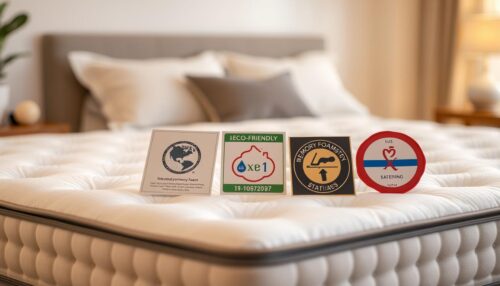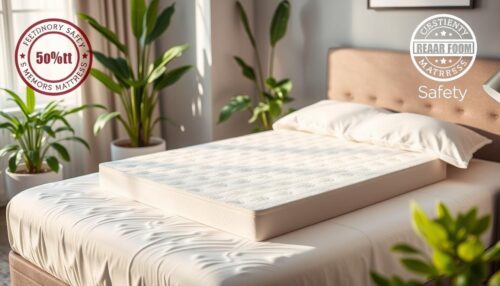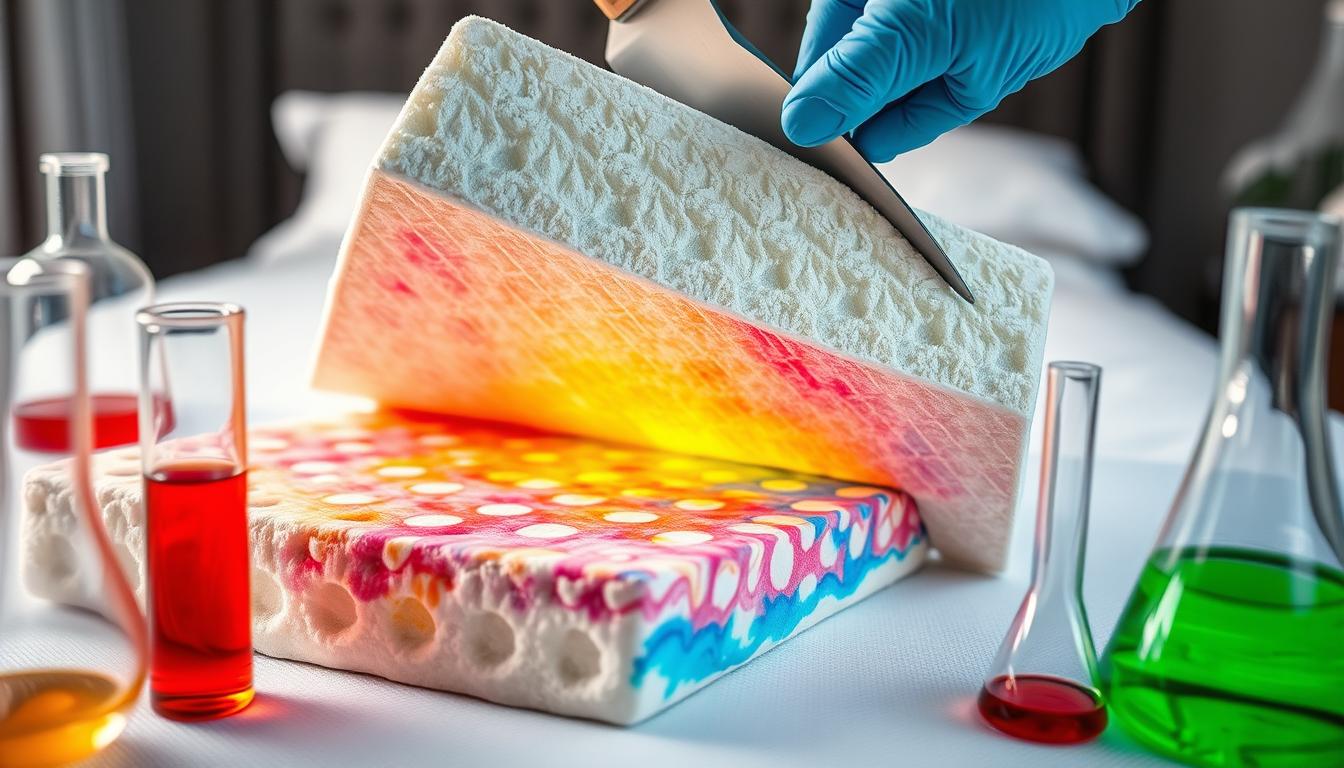Disclosure
This website is a participant in the Amazon Services LLC Associates Program, an affiliate advertising program designed to provide a means for us to earn fees by linking to Amazon.com and affiliated sites.
Memory foam mattress toppers are popular for extra comfort and support. But, there are worries about their safety. Modern making has cut down on harmful chemicals. Yet, some toppers might still have bad stuff like formaldehyde and toluene.
Before getting a memory foam topper, it’s key to know the risks. Look for safer choices that won’t harm your health.
Key Takeaways
- Memory foam is made from polyurethane, a synthetic material, and may contain potentially toxic chemicals.
- Older memory foam toppers were more likely to off-gas volatile organic compounds (VOCs) that can cause health issues.
- Certifications like CertiPUR-US can help identify memory foam products with low levels of harmful substances.
- Choosing eco-friendly, plant-based memory foam options can reduce your exposure to toxic chemicals.
- Proper ventilation and regular cleaning can help minimize the risks of memory foam off-gassing.
What is Memory Foam Made Of?
Memory foam is a popular choice for mattress toppers. It’s mainly made from polyurethane foam, a synthetic material from petroleum. The foam is made with polyols and diisocyanates like toluene diisocyanate (TDI) and methylene diphenyl diisocyanate (MDI). These chemicals mix to form the foam’s structure.
Understanding Polyurethane Foam
Polyurethane foam is the base of memory foam. It’s made by mixing polyols with diisocyanates. This mix creates a foam that can be shaped and molded.
The foam is then mixed with more chemicals. These add-ons improve its feel and performance. This is what makes memory foam so special.
Chemicals Used in Production
- Polyols – Organic compounds that are foundational for polyurethane foam and widely used in various products.
- Diisocyanates – Organic compounds that are combined with polyols to create polyurethane.
- Blowing Agents – Chemicals used to create the foam’s structure, with eco-friendly water-based alternatives replacing traditional CFCs in modern production.
- Flame Retardants – Substances added to improve fire safety, such as boric acid, which can cause skin and respiratory irritation.
These chemicals, along with others, give memory foam its unique qualities. But, they’ve also raised worries about safety and off-gassing. Knowing what’s in memory foam helps us make better choices.
The Toxicity Debate
The debate about memory foam mattress toppers focuses on chemicals and health risks. People worry about VOCs, flame retardants, and long-term effects of synthetic materials. But, not all memory foam toppers are toxic.
Common Concerns About Toxicity
People worry about health risks from memory foam toppers. Memory foam can release VOCs that irritate and may harm health over time. Flame retardants in many mattresses also raise health concerns, leading to laws to limit their use.
Are All Mattress Toppers Toxic?
- Newer models and those from trusted brands use safer materials and methods, lowering chemical risks.
- Certifications like CertiPUR-US and GREENGUARD Gold mean less harmful chemicals and emissions. They help find chemical-free sleep solutions.
- Groups like Clean and Healthy New York and Made Safe push for safer mattress chemicals. They highlight the need for eco-friendly mattress toppers.
Even with ongoing debates, there are many memory foam toxicity concerns and chemical-free sleep solutions. By looking into eco-friendly mattress toppers and understanding certifications, you can choose wisely for your health.
Off-Gassing: What You Need to Know
Ever opened a new memory foam mattress topper? You’ve probably smelled that “new mattress smell.” This smell is called off-gassing. It happens when the topper releases volatile organic compounds (VOCs) from its synthetic materials.
What is Off-Gassing?
Off-gassing means VOCs are released from products like memory foam mattress toppers. These VOCs can make your eyes, nose, and throat feel irritated. People with sensitivities might feel it more.
The smell’s strength can depend on the foam’s density. Thicker foams tend to smell more.
How Long Does It Last?
The bad news is, off-gassing smells can last a while. Studies say it can go on for up to 4 weeks. But, airing out the topper when you first use it can help.
Most people won’t get sick from these smells. But, some might feel sick. They could have trouble breathing, headaches, or feel nauseous. The smells aren’t toxic, but some chemicals in them might be bad for you.
To stay safe, choose memory foam mattress toppers that are CertiPUR-US® certified. These toppers are made without harmful chemicals. They usually smell less and for a shorter time.
Identifying Toxic Materials
Choosing a safe mattress topper is key. It’s important to know about certifications and standards. The CertiPUR-US certification is well-known in the mattress world.
CertiPUR-US Certification Explained
The CertiPUR-US certification checks foam products for harmful chemicals. It makes sure the foam is free from bad stuff. This includes ozone depleters, phthalates, and heavy metals.
It also checks for low VOC emissions. This means the air inside is healthier.
Other Certifications to Look For
- OEKO-TEX Standard 100 – This checks for harmful substances in textiles, like cotton or wool mattress toppers.
- GREENGUARD Gold – This focuses on low chemical emissions. It ensures mattress toppers meet strict air quality standards.
These certifications help find safe and eco-friendly mattress toppers. They reduce the risk of toxic material exposure.

Looking for these certifications makes choosing a non-toxic mattress topper easier. It ensures your health and well-being are a priority.
Health Risks Associated with Toxic Toppers
Memory foam mattress toppers can be harmful. They release chemicals that can hurt your health. These chemicals can cause short-term and long-term problems.
Short-Term Effects on Health
Short-term issues include headaches, nausea, dizziness, and breathing problems. These happen because of chemicals released by the toppers. These problems usually go away as the chemicals fade.
Long-Term Health Risks
The long-term effects are not fully known. But, studies suggest they might harm your breathing, hormones, and even increase cancer risk. More research is needed to understand the dangers of memory foam toxicity concerns.
Knowing the health impacts of memory foam toppers is key. They can greatly affect your health. Choosing chemical-free sleep solutions is a smart move for those worried about memory foam toxicity concerns and wanting a healthy sleep space.
| Short-Term Effects | Long-Term Health Risks |
|---|---|
|
|
Choosing Safe Mattress Toppers
Choosing a safe mattress topper is key. Look for ones made from natural, non-toxic materials. Stay away from memory foam toppers because they can release harmful chemicals.
Instead, think about organic latex or wool. These are better choices.
Look for Eco-Friendly Options
Choose mattress toppers that are certified organic. They should have at least 95% organic content. Avoid products with polyurethane foam, flame retardants, PVC, and vinyl covers.
These can pollute the air inside your home. Natural latex is a good option. It fights mold, dust mites, and lasts longer than foam made from petroleum.
Recommended Brands with Safety Standards
When you’re looking for a safe topper, check out Avocado, Naturepedic, and PlushBeds. These brands use safe, eco-friendly materials. They also have third-party certifications like CertiPUR-US to lower VOC emissions.
Make sure the topper is free from harmful chemicals. It should also be comfortable and supportive for a great sleep.
Ways to Reduce Risk
Memory foam mattress toppers can be safe and comfy. Just follow a few easy steps to avoid risks. This way, you can enjoy your topper without worrying about toxins or off-gassing.
Proper Ventilation During Setup
First, let your memory foam topper off-gas properly. Open your windows and use fans when you first unpack it. This helps get rid of harmful chemicals.
Let the topper air out for 24-48 hours before using it. This is important for your safety.
Regular Cleaning and Maintenance
Take care of your topper to avoid toxins. Vacuum it often to remove dust and allergens. For spills, use a mild detergent and avoid harsh chemicals.
Using a chemical-free sleep solutions like a breathable cover helps too. It acts as a barrier against off-gassing odors or compounds.
By following these steps, you can make your sleep safer and more comfortable. Good ventilation and regular care are key. This way, you can enjoy memory foam without health worries.
Consumer Reports and Safety Ratings
Recent studies on mattress topper safety show mixed results. Some studies point to health concerns, while others find little risk if products follow safety standards. Organizations like Consumer Reports and the Environmental Working Group (EWG) offer important info on safety and performance.
Overview of Recent Studies
Consumer Reports looked at over 200 mattress and bedding items, including memory foam toppers. They found that high-quality memory foam mattresses, costing more than $500, usually meet safety standards. These mattresses also release fewer harmful chemicals.
But, cheaper models might have dangerous chemicals like flame retardants and formaldehyde.
Trusted Sources for Consumer Safety
- The Environmental Working Group (EWG) is a respected non-profit. They deeply analyze the safety of consumer products, including mattress toppers.
- The National Center for Health Research is another trusted source. They offer independent research and advice on health risks from chemicals in household items like mattress toppers.
By checking these reliable sources, you can choose a safe and comfy mattress topper. You’ll get one that fits your needs without harming your health.

The Role of Regulations
In the United States, the mattress industry follows many rules to keep consumers safe. The Consumer Product Safety Commission (CPSC) watches over mattress safety closely. They focus on how well mattresses burn. The Environmental Protection Agency (EPA) doesn’t have much power over household items. So, the industry itself often checks for chemical safety.
Government Regulations on Mattress Safety
The Flammable Fabrics Act (FFA) and CPSC rules like 16 CFR Part 1632 and 16 CFR Part 1633 set strict rules for mattresses. These rules make sure mattresses don’t catch fire easily. They also require mattresses with fire retardants to tell consumers about it.
Industry Standards and Compliance
Many top brands do more than just follow the law. They use programs like CertiPUR-US and GREENGUARD. These programs have stricter rules than the law for chemical safety. This gives shoppers peace of mind.
Knowing about government rules and industry standards helps you choose a safe mattress. You can pick a non-toxic memory foam mattress that fits your health needs.
Frequently Asked Questions
Many people worry about memory foam mattress toppers being toxic. But, not all of them are dangerous. It’s important to pick a safe, chemical-free one for your bed.
Are All Memory Foam Toppers Dangerous?
No, not all memory foam toppers are harmful. Look for ones with high-quality, CertiPUR-US certified foams. This means they don’t have bad stuff like formaldehyde or heavy metals.
Choose toppers from brands that are open about what they use. These are usually safer.
What Should You Avoid When Shopping?
- Stay away from toppers with strong smells. This could mean they’re off-gassing harmful chemicals.
- Don’t pick toppers without safety certifications like CertiPUR-US or OEKO-TEX Standard 100.
- Be careful with toppers from unknown brands. They might use bad materials and not follow strict rules.
- Don’t go for very cheap toppers. They might not be safe. Instead, choose ones that are safe and not too expensive.
When you’re looking for a memory foam topper, find companies that are clear about what they make. This way, you can choose a chemical-free sleep solutions that’s good for you.
Conclusion: Are You at Risk?
There are worries about memory foam toxicity, but you can lower the risk. Choose certified, high-quality products and follow setup and maintenance tips. Memory foam toppers offer comfort and pressure relief, but think about the risks.
Make a choice that fits your health needs, environmental concerns, and what you like. This way, you’ll pick the best mattress topper for a safe, comfy sleep space.
Final Thoughts on Safety and Comfort
The mattress industry has worked hard to tackle memory foam toxicity worries. They have rules and checks to keep you safe. Still, it’s important to know what’s in your mattress topper.
Go for chemical-free sleep solutions and follow care tips. This way, you can enjoy memory foam’s benefits without health risks.
Making the Best Choice for Your Sleep
It’s key to find a balance between mattress topper safety and what you like for sleep. Look at certifications, off-gassing, and health effects of memory foam toppers. If you’re worried, consider natural latex or organic cotton.
By choosing wisely, you can make a sleep space that’s good for you. It will also be comfy, just how you like it.

